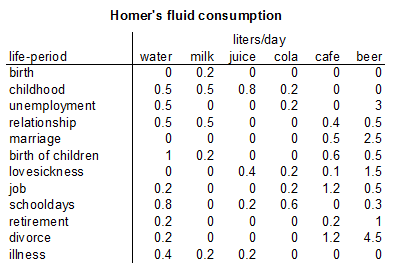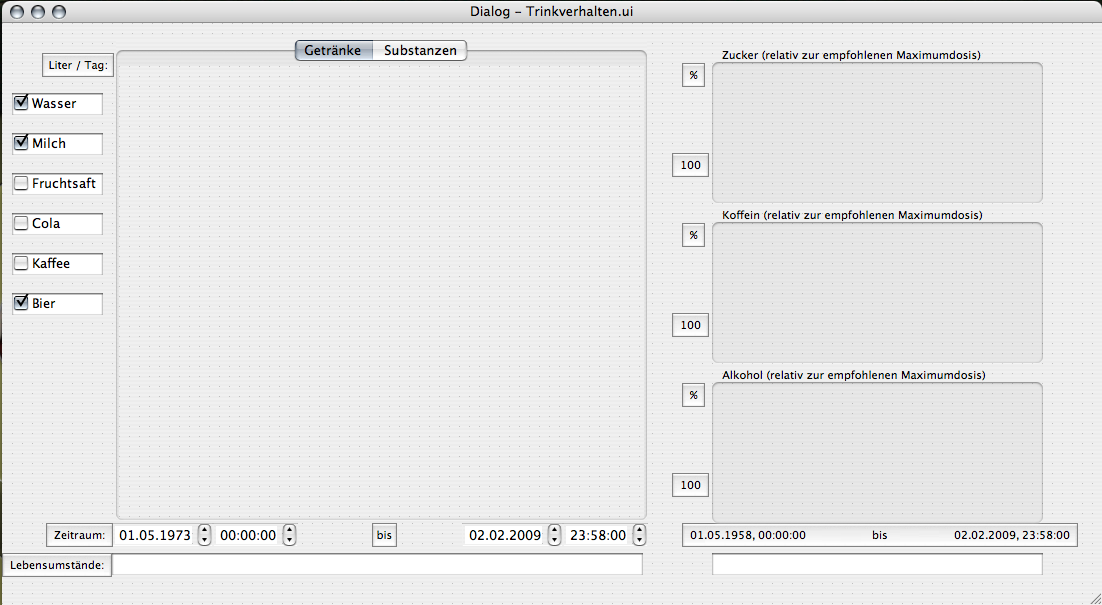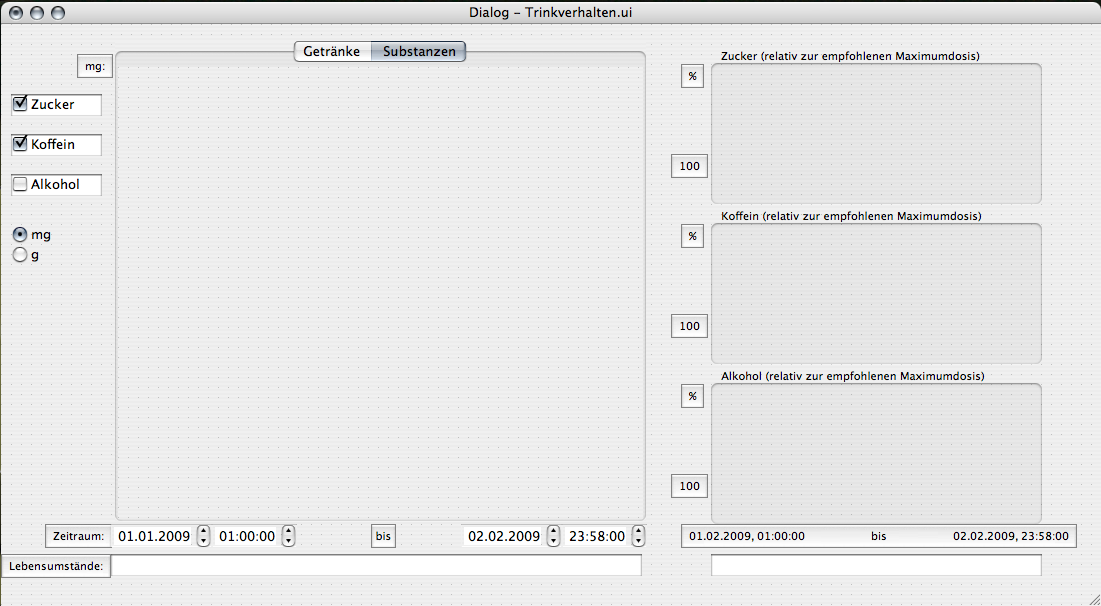Teaching:TUW - UE InfoVis WS 2008/09 - Gruppe 02 - Aufgabe 4: Difference between revisions
No edit summary |
No edit summary |
||
| Line 73: | Line 73: | ||
Figure 1 shows three different drinks in the all life periods, so it is made for the physiological interest on the relation between the drinking habits and the time of his life. | Figure 1 shows three different drinks in the all life periods, so it is made for the physiological interest on the relation between the drinking habits and the time of his life. | ||
[[Image: | [[Image:GetraenkeView life.png|center|400px|thumb|Fig.1: Drinks-view with selected bar.]] | ||
Figure 2 is made for the medicinical interest on the deviation to the recommended maximum dose. | Figure 2 is made for the medicinical interest on the deviation to the recommended maximum dose. | ||
[[Image: | [[Image:SubstanzenView day.png|center|400px|thumb|Fig.2: Substance-view with selected bar.]] | ||
Additionally we think about a drag-and-drop and copy-option for the different life periods, because maybe Homer has more than one time lovesickness. | Additionally we think about a drag-and-drop and copy-option for the different life periods, because maybe Homer has more than one time lovesickness. | ||
Revision as of 06:22, 1 February 2009
Aufgabenstellung
Gegebene Daten
Homer Simpson's Trinkverhalten in Abhängigkeit von seinen Lebensumständen
...Visualisierung von Homer's Lebensabschnitten bzw. Ereignissen mit Einfluss auf sein
Trinkverhalten (zB.: Kindheit, Pubertät, Arbeitslosigkeit, Beziehungen, Hochzeit, Geburt
der Kinder, Liebeskummer, Alltag, etc.) von seiner Geburt bis Jetzt + mögliche
Zukunftsszenarien (mind. 3).
- Die Menge folgender Getränke soll für die jeweiligen Lebensumstände ablesbar sein
(ml oder Liter - je nachdem - pro Tag, Monat, Jahr (z.B.: Fokus+Kontext Methoden):
a) Wasser
b) Milch
c) Fruchtsaft
d) Cola
e) Kaffee (Würfelzucker?)
f) Bier
(vereinfacht angenommen, Homer trinkt ausschließlich diese Getränke)
- Die folgenden Werte sollen abhängig von den konsumierten Getränken ablesbar sein:
1) g oder kg konsumierter Zucker (aus Getränken) + empfohlene Maximaldosis pro Tag, Monat, Jahr (empfohlene Maximaldosis/Tag: 50g; enthaltener Zucker: 10g/100 ml Cola; 10g/100 ml Fruchtsaft; 3g/Würfelzucker).
2) mg konsumiertes Coffein + empfohlene Maximaldosis pro Tag, Monat, Jahr (empfohlene Maximaldosis/Tag: 600mg; enthaltenes Coffein: 10 mg/100 ml Cola; 80 mg/100 ml Kaffee).
3) g konsumierter Alkohol + empfohlene Maximaldosis pro Tag, Monat, Jahr (empfohlene Maximaldosis/Tag: 20g; enthaltener Alkohol: 3,6 g/100ml Bier)
- Die Daten sollen zur medizinischen/psychologischen Analyse visualisiert werden.
- Die bisher erlernten Design-Prinzipien sollen umgesetzt werden (z.B.: Optimierung der Data-ink ratio).
- Die Mockups sollten zumindest 1) Homer's Leben im Überblick 2) und eine Detailansicht wiedergeben.
- Alle nicht angeführten Daten können frei erfunden werden.
Description
- Application area analysis & dataset analysis
The predefined dataset describes Homer Simpson's lifetime beverage consumption.
We distinguish between beverages (water, milk, juice, cola, café, and beer), contained substances (sugar, alcohol, caffeine), and their according recommended daily allowance (RDA). As actual data, we store ingested liters of fluids and the time of consumption (=life-period like child ship, puberty, unemployment, marriage, birth of children, retirement, divorce, illness,..).
For measurement of consumed drinks, we use the ordinal data type Liter and for substances kilogram or gram, the life period is considered as nominal type and can also directly be linked to a specific age or time span. This results in a dataset structure of two dimensions with additional date-selection.

- Target group analysis
The visualization is tended for medical and psychological stakeholders an their patients; to discuss easily the problems of their drinking habits and their solution. The medical view expresses the consumption of substances like sugar, alcohol and caffeine whereas the psychological view details the intake of fluids. With Homer Simpson’s dataset it is also possible to demonstrate the overall intake of amounts of sugar and similar harmful substances to children. Nevertheless the interface for the visualization should be easily comprehended and user friendly to be able to be operated by different target groups.
- Goal
The goal of the visualization is to get a quick and detailed overview on Homer Simpson’s drinking behavior depending his current life period and circumstances. It should be possible to identify the accumulated quantities of substances in relation to the recommended maximum dose. The interactive visualization should also offer an option to select considered fluids.
Concept
- Visualization
We should use graphs, when the message is contained in the shape of the values and the document you produce will be used to reveal relationship among multiple values [Few, 2004]. In our task about Homer Simpson's drink consumption are too much different values that have to be shown, that a table all alone won't show the information clearly enough.
- Visual Mapping
We separate the two different views for medical and psychologic interests:
On the psychologic or "drink"-view of our data, the drinks to be shown are selected:
The different life periods are mapped onto the x-axis and the consumed amount (in liters) onto the y-axis.
On the medical or "substance"-view, the sugar-, caffeine- and alcohol-rates can be examined:
Again, the various life periods are shown on the x-axis. For each period, the amounts of consumed substances sugar, caffeine and alcohol are mapped onto the y-axis in multiples of the according RDA. We put a horizontal line where y equals one RDA. That way, it is easy recognizable which substance consumption exceeds one RDA.
- Description of the technologies
We use a bar diagram to show our nominal dataset, because a simple comparison of the categorical subdivision of one or more measures in no particular order can be shown very easy by this visualization[Few, 2004].
On the "substance"-view, we decided to show (for the medicine view) the differences to the maximal dosis by mapping the substances on an RDA scale, where the maximum dose is clearly shown by the horizontal line [Few, 2004]. The bars then show whether Homer Simpson's drinking behavior was adequate for each period, and if not, by how much one RDA was exceeded.
- Interaction
The user can choose between the drinks-view and the substances-view by selecting the according radio button left of the currently displayed diagram (panel "Anzeige"). In the panel "Getränke", one can select up to three drinks for simultanous comparison. This can be done independently form the current view.
In the "drinks"-view, the legend above the diagram defines the bar colors for all drinks. When a single bar is selected, a floating panel emerges showing the exact consumption of the according drink for that period. Further, all contained substances are listed with their exact value and unit.
In the substances-view, the legend above the main diagram defines the colors for the three covered substances. If a single bar is selected, the emergin panel reveals the exact amount and unit of the according substance consumed in that period, the appropriate RDA value, the substance-specific RDA in its unit (gram, milligram) and a breakdown into drinks, so that one can track the ratio of each drink that contributes to the total.
- MockUp
Figure 1 shows three different drinks in the all life periods, so it is made for the physiological interest on the relation between the drinking habits and the time of his life.

Figure 2 is made for the medicinical interest on the deviation to the recommended maximum dose.

Additionally we think about a drag-and-drop and copy-option for the different life periods, because maybe Homer has more than one time lovesickness. Also more than the given drinks could be added.
References
- [Few, 2004]:Stephen Few, Show Me the Numbers: Designing Tables and Graphs to Enlighten, Analytics Press, 2004, Appendix A - Table and Graph Design at a Glance.